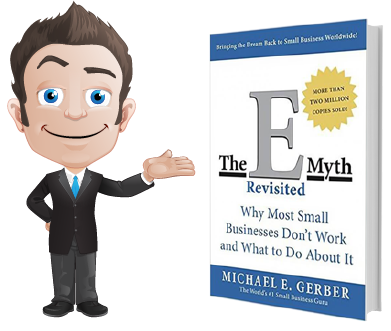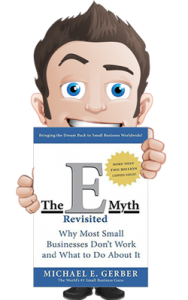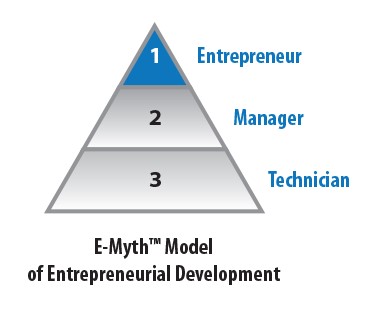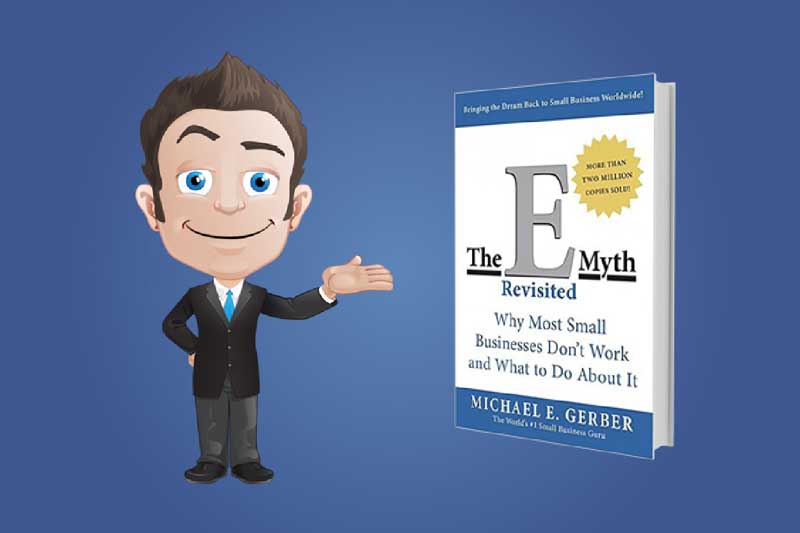The E-Myth Revisited (Definitive Book Summary)
By Michael E. Gerber
Why Most Small Businesses Don’t Work
Find Out The 7 (Actionable) Steps To Change All That...


Overview
The E-Myth Revisited (Entrepreneurial Myth) is one of the seminal business books that all entrepreneurs should read. It promotes the vision of author Michael E. Gerber, who believes all businesses should develop extraordinary systems to reach a new level.
It’s so easy to read. Most business books are awful in that they are full of jargon and only serve to inflate the author’s ego. This book is easy to read, engaging, and full of great lessons.
Drawing a distinction between working on your business and working in your business, The E-Myth covers all stages from starting up through growth, and it looks at ways that the franchising model can be applied to any business – even one that’s not a franchise.
The Best Bit… You’re going to learn everything you need to make a difference, in just 7 actionable steps!
So… What are you waiting for?
Let’s open with honesty. Do any of these sounds familiar to yuo?
- I’m not making enough profit
- I’m not making enough money (i.e., I don’t have enough money in my pocket)
- I’m not getting enough customers
- I can’t find good people
- I don’t have any free time
- There is not enough time in the day to get everything done
- My business depends too much on you
If you answered YES to any of these, I am about to change your life…
Forever!!!
Don’t worry you’re not alone. Most business owners I meet are in the same boat.
These problems are difficult, if not impossible, to get out of, unless…
You have a system that produces the right results.
That’s where The E-Myth Entrepreneurial Model comes in.

According to Gerber, author of “The E-Myth Revisited,” the solution involves thinking about your business as if it’s a franchise – a proprietary way of doing business that successfully differentiates every extraordinary business from their competitors.
In simple terms “work on your business rather than in it.”
Easier said than done, I hear you say…
Question: How can the E-Myth Revisited Workbook help?
Answer: Would you like step-by-step instructions on how to achieve your goal?
In this book and summary, you’ll find the answer to the following questions:
- How can I get my business to work without me?
- How can I get my people to work, but without my constant interference?
- How can I systematize my business in such a way that it could be replicated 5000 times so that the 5000th unit would run as smoothly as the first?
- How can I own my business, and still be free of it?
- How can I spend my time doing the work I love to do, rather than the work I have to do?
Understanding the Rules
Here are the 7 rules you’ll need. Follow them, and your business will run on autopilot producing predictable results:
- The model will provide consistent value to your customers, employees, suppliers, and lenders, beyond what they expect.
- The model will be operated by people with the lowest possible level of skill.
- The model will stand out as a place of impeccable order.
- All work in the model will be documented in Operations Manuals.
- The model will provide a uniformly predictable service to the customer.
- The model will utilize a uniform color, dress, and facilities code.
There are 7 distinct steps to get there,
Ready to start making some money, ready to get your time back? Ready to be stress-free (ish)?
Let’s dive in…
Point 1
Your Primary Aim
Every entrepreneur starts a business for themselves. However, we often get so tied up in the day to day STUFF that we forget the single most crucial thing… the ultimate aim of the business is to serve us.

Here are the questions to be answered with 100% clarity, if you want your business to serve you, and not the other way around.
- What do I wish my life to look like?
- How do I wish my life to be on a day-to-day basis?
- What would I like to be able to say I truly know in my life, about my life?
- How would I like to be with other people in my life – my family, friends, business associates, customers, employees, and community?
- How would I like people to think about me?
- What would I like to be doing two years from now? Ten years? Twenty years? When my life comes to a close?
- What precisely would I like to learn during my life – spiritually, physically, financially, technically, intellectually? About relationships?
- How much money will I need to do the things I wish to do? By when will I need it?
Point 2
Your Strategic Objective
Your Strategic Objective is an unequivocal precise statement: What your business has to do in order to achieve your Primary Aim.

This is your list of standards, your personal KPI’s that you use in order to measure your progress towards your ultimate goal.
There are many standards you can include, but the first two MUST BE:
1. Be clear on how much money your company will make when it is ultimately “done”.
Will it be a $1 million a year company?
Will it be a $500 million a year company?
Or maybe something else?
Remember Tax – How much profit after-tax will your company make?
That will be the money you will use to build the life that you want – Your Primary Aim.
#Turnover is for vanity, #profit is for sanity.
Shane Stamford Tweet
2. Build a business that can fulfil the financial standard you’ve set with the first standard.
This tells you what kind of business you need to create, and defines who your customer will be.
The harsh reality…
Is your business model able to achieve this? If not…
You have to change it!!!
If you don’t, it is IMPOSSIBLE to achieve your Primary Aim – The life you want.
Now that you have these two standards dialed in, you can create as many standards as you want.
Need some help?
Here you go just answer some of these questions:
- When is the ultimate version of your company (this is called your prototype) going to be finished?
- Where are you going to be in business? Locally? Regionally? Internationally?
- What type of business are you going to be? Retail? Wholesale? Something else?
The standards that you ultimately create for your business will become the business you strive for.
Many entrepreneurs never climb their way out of day-to-day operations – the small STUFF. They are always working in their business not on their business because they skip this step.
Point 3
Your Organizational Strategy
Most companies organize themselves around personalities when they should organize it around functions…

The reality is, that most companies organize themselves around personalities when they should organize it around functions.
Build your business prototype, determine the exact organizational structure that you will need, so that you can execute it towards your strategic objective.
Keep reading… Here’s how you want to do it:
- Build an organizational chart for what your business will ultimately look like.
For example, you might need a CEO (which may or may not be you), a Vice President of Sales, Relationship Managers, and so on. - Put your name next to the positions that you currently fill.
When you are starting out, no doubt this is likely to be all of them. - Create very detailed descriptions of each one of the positions – these are your Position Contracts.
The reality is, that most companies organize themselves around personalities when they should organize it around functions.
IMPORTANT: This is a summary of the results that need to be achieved by each position in the company, the work the person is responsible for, a list of standards that the results are to be evaluated against, and a line for the signature of the person who agrees to fulfil those responsibilities.
- Sign your name to each of the contracts you currently fill.
The insight here is that you should create the system inside your business based on the standards you want to set – rather than letting other people do it for you, which is usually what happens.
Let’s face it – most, if not all, Entrepreneurs are control freaks; we don’t let go.
You need to rest easy knowing that the tactical parts of the business are being taken care of, otherwise YOU’RE NOT going to free yourself up to work on the critical strategic parts of your business.
For example, don’t place an ad for a salesperson until you have created the Sales Operations Manual for your company.
Once you have created the position contracts for each and every role in your company, you will then know precisely which standards you need to be hiring against.
Never again will you recruit the wrong people!
Learn how to work on and in your #business at the same time. Work on a vision and direction. Read the #E-Myth #Revised Definitive Book Summary
Shane Stamford Tweet
Point 4
Your Management Strategy
Once your organizational strategy is created, we can move on to your management strategy.
Ready?

Bottom Line: Your management strategy is the system we create for the business.
It shouldn’t, and can’t rely on, expensive and talented people.
No, it’s not a misprint, hear me out…
The more automated and specific your system is, the more effective it will be.
At its core, it is a series of checklists for everything that needs to be done inside the business.
A hotel would have a series of checklists for:
- People who clean the rooms
- People responsible for checking in guests
- Customer services
- Complaints
And so on.
Finally, you need a mechanism built into your system, for making sure that the work in the checklists is done properly.
For example, you could have your staff sign the checklist at the end of each job, so you know that the work has been completed, based on the steps in your standards.
Business is business, and if you have systems in place, it is easier to make tough decisions. Make it a fireable offense to sign off on work that hasn’t been completed.
The benefits of a system like this are clear.
You will be able to hire new staff, train them up so that they’ll be quickly performing the tasks, and producing identical results based on your standards.
Point 5
Your People Strategy
The heart of your people strategy is creating an environment where “doing it” is more important to your staff than not doing it.

We’ve all been there: staff going home at the end of the day, leaving the lights on, not turning their desktop off, work not finished…
One of the critical parts of a “doing it” culture is to ensure that the people you hire understand the reason behind the work they are being asked to do.
I don’t want to burst your ego but… people do not merely want to work for exciting people.
They want to work for people who have created a clearly defined structure for achieving in the world. A structure through which they can test themselves and be tested.
In short, a game.
But…
The key to get the perfect staffing culture is to make sure you are creating a game worth playing.
TOP TIP: Set the tone for the game at the beginning of your relationship with your employees – before they are hired.
- A scripted presentation, communicating the Boss’ idea in a group meeting, to all the applicants at the same time. It describes your idea, but also the history of the business, and the success gained from implementing the idea, plus what would be required for the position of a successful candidate.
- Meet with each applicant individually, to discuss their reactions to your idea, and ask them why they consider themselves a good fit to implement the idea.
- Notify the successful candidate by phone with a scripted presentation.
- Notify the unsuccessful applicants, thanking them for their interest.
- On the first day of training, the boss should do the following:
- Your Boss’ strategy;
- Summarize the system through which the entire business brings that idea to reality;
- Take the new employee on a tour of the facility, highlighting the staff and systems that bring the idea to life;
- Answer the employee’s questions clearly and fully;
- Review the Operations Manual with the employee, including the Strategic Objective, the Organization Strategy, and the Position Contract for the employee’s position.
- Complete the employment papers.
Strive to develop a lasting #brand as you #build your business. Understand your #customer #experience.
Shane Stamford Tweet
Point 6
Your Marketing Strategy
Let’s face it everyone overcomplicates marketing, especially marketing people, right?

It all comes down to what your customers want and how you deliver it. Your marketing strategy lives and dies by this.
Understanding what your customer wants depends on you recognizing the two pillars of a successful marketing strategy:
TOP TIP: Research your competitor:
- What other brands do they buy?
- How are those companies – who are already successfully selling to those people – sell to them?
- What colors do they use?
- What messages are they sending?
- What values do they seem to be promoting?
Once you have this information, you can take all of this and figure out what your business must be in the mind of those customers, in order for them to choose you over everybody else.
Finally, make a promise your customer wants to hear. Align your entire organization around delivering on that promise, better than anyone else on the block.
Of course, this keeps changing as your company continues to grow. You will always be learning about the demographics and psychographics of your customers and continually updating your marketing strategy.
When you first start your business, you should already have defined the demographics of your customers. If you haven’t, take a look at our business and marketing plan guide.
Your next job is to figure out as much of the psychographics for that segment of the market as possible.
Point 7
Systems Strategy
The last piece of the business growth jigsaw is your systems strategy.

The E-Myth mastery PDF shows there are 3 kinds of systems.
Hard systems are inanimate, unliving things. Soft systems are living things or ideas. The core of the E-Myth audiobook and E-Myth summary so far have been a combination of the two systems.
The third system is the information system, providing information about the interaction between the other two.
I strongly, strongly, strongly recommend you get an automated business CRM system.
As an example, if you have a sales system that tracks the sales steps from beginning to end (you should), you would be tracking some or all of the following items (THIS SHOULD BE AUTOMATED) :
- How many calls were made?
- How many prospects were reached?
- How many appointments were scheduled?
- How many appointments were confirmed?
- How many appointments were held?
- How many Needs Analysis Presentations were scheduled?
- How many Needs Analysis were confirmed?
- How many Needs Analysis were completed?
- How many Solutions Presentations were scheduled?
- How many Solutions Presentations were confirmed?
- How many Solutions Presentations were completed?
- How many solutions were sold?
- What was the average dollar value?
In short, the information system should tell you everything you need to know about how your people are performing, so that you can meet your strategic objectives to achieve your primary aim.
What Did You Think?
I’d love to hear what you think about my E-Myth Revisited book summary and review…
What did you think? Or maybe you have a question about something you’ve read…
Either way, leave your comments below and I’ll mke sure to answer as soon as they come in.


